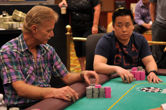Six Kinds of Players Are Taking in the Flop: Which Are You?

This entire article is about a roughly two-second-long window of time that occurs in every hand of hold’em and Omaha. It’s the moment that the three flop cards are revealed. I’ve noticed six distinct ways that people behave in this brief interval.
1. The Watcher

The most natural and obvious thing to do is watch the cards being turned over and spread out. The flop is often a make-or-break point, so of course you want to know what it has brought you.
The problem with watching the flop is that if you’re not careful, you can give away crucial information about whether or not it improved your hand. The classic tell of a player who liked the flop is that after taking it in, his eyes will next move to his chip stacks as he starts to think about how much to bet. Conversely, a player who is disappointed in the flop will stare at it longer, searching for anything useful — maybe an inside straight draw, or some sort of runner-runner combination that can salvage an unpromising situation.
2. The Robot
This player has learned about the potential information leak from a variable reaction to the flop. To defend against it, he has trained himself to follow a strictly consistent pattern with his gaze. Perhaps he’ll look at the cards for a count of three, then shift to watch the player who is first to act. But whatever his ritual, he does it the same every time. Leak plugged.
3. The Watcher Watcher

Like the robot, this kind of player has become aware of the well known flop-watching tell. But rather than just suppress it in himself, he has decided to exploit it in others. So instead of looking at the cards, he’s looking at the other players — watching the Watchers.
There are different ways of doing this. He might try to glance around at everyone else as quickly as possible, trying to spot somebody whose reaction is particularly pronounced. Or he might focus on the player who will be first to act. Or he might have already determined who does and does not give off a flop-looking tell, and pay attention only to the ones who do. Whichever method he chooses, he’ll glean what information he can from his opponents, and only then look down at what the dealer has done.
4. The Glancer
This is a variation of the Watcher Watcher. He takes one quick glance at the flop for himself before shifting to take in other players’ reactions. It’s like what Jerry famously said, in another context, in an episode of Seinfeld — “You don’t stare at it — it’s too risky! You get a sense of it and then you look away!”
The advantage of this approach is that you have a context in which to interpret any reactions you see. The disadvantage is that those reactions can be fleeting, and you might miss them. If you can’t take in the flop with about half a second or less of a look, this probably isn’t for you.
5. The Drama Queen

I have known only one person in this category — a friend of mine who likes to make a show of not watching the flop. He’ll conspicuously cover his eyes, or turn his head completely away, and sometimes even announce out loud, “I’m not looking!”
It’s certainly true that this prevents anybody else from picking up a tell from your reaction, because you’ll have none. But the disadvantages are obvious. First, you’re foregoing any opportunity to gauge opponents’ reactions. Second, you’re cluing in the clueless that there is a entire information war taking place right under their noses that they weren’t aware of. Smartening up the least skilled players is never smart strategy.
6. The Reverser
Finally, there’s the player who has realized somebody else at the table is a Watcher Watcher, and who won’t just let it happen.
In poker, as in judo, you can sometimes use an opponent’s moves against him — and this is one such situation. With some practice, you can train yourself to do the opposite of the standard tell. Stare at a flop you love, or quickly look down to your stacks if it’s one that you’ve missed completely. The former allows you to slow play a big hand; the latter sets you up to bluff.
This tactic works best in heads-up pots, so that other players don’t interfere with your sneaky plan. And you’ll probably only get away with this once for any particular Watcher Watcher you’re playing against, so be sure to make it count. If you’re really gutsy, you can set up the Watcher Watcher for a big fall if you first give him a series of honest, classic tells, so as to convince him that he can rely on what he’s seeing you do — then hit him with the reverse.
Conclusion
Me? I shift around between Robot, Watcher Watcher, Glancer, and Reverser, depending on factors such as the skill level of the other players, my own alertness, and how much distraction there is at the table. I think any of them are fine, with only Watcher and Drama Queen being patterns one should avoid.
The most important thing is to be aware of and in control of what you’re doing — every time, and with every flop.
So when the flop comes, which of these six are you?
Robert Woolley lives in Asheville, NC. He spent several years in Las Vegas and chronicled his life in poker on the “Poker Grump” blog.
Want to stay atop all the latest in the poker world? If so, make sure to get PokerNews updates on your social media outlets. Follow us on Twitter and find us on both Facebook and Google+!










